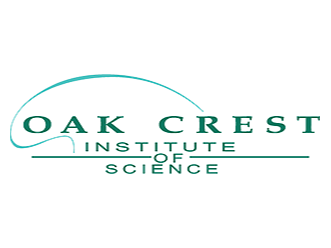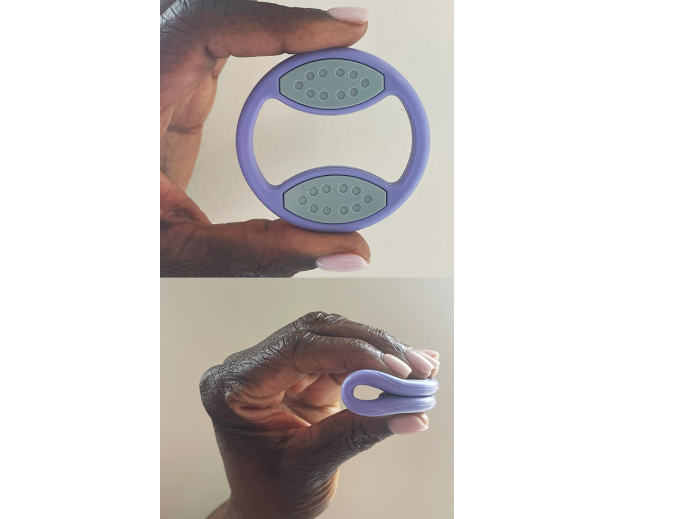Type of technology
Intra-vaginal ring
Administration route
Topical (Vaginal)
Development state and regulatory approval
Soluble adenyl cyclase (sAC) inhibitors
Pre-clinical
Not provided
Description
The dual-purpose vaginal ring is a silicone-based, doughnut-shaped vaginal ring designed for monthly contraception and prevention of diseases. It has an outer diameter of 55 mm and incorporates two drug delivery cassettes. One cassette contains a novel antiviral peptide, which is a protein fragment, while the other cassette delivers a hormone-free contraceptive agent—a soluble adenyl cyclase (sAC) inhibitor. Both active agents are released simultaneously at a controlled rate over a 28-day period.
Developer(s)

The Oak Crest Institute of Science was founded in 2001 in Monrovia, California, by Dr. Marc Baum. It began as an independent, non-profit research organization with a mission to conduct impactful scientific research while training the next generation of scientists. Over the years, it has grown into a hub for interdisciplinary research, focusing on drug delivery and infectious diseases.
Technology highlight
1. Sustained Release: Enables controlled and simultaneous release of two distinct drugs within the vaginal flora, ensuring localized and prolonged therapeutic efficacy. 2. Self-Administration: Designed for ease of use, allowing users to independently insert and remove the device. 3. Cost-Effectiveness: Low manufacturing costs make it an accessible option for widespread use. 4. Extended Shelf Life: Exhibits a longer shelf life compared to other long-acting contraceptive formulations, enhancing storage stability and usability.
Illustration(s)
Technology main components
The Onering is a silicone-based, doughnut-shaped vaginal ring featuring two distinct lobes. Each lobe consists of a reservoir support structure enclosed by a rate-controlling membrane and sealed with a reservoir end cap. (i) Lobe One contains a novel antiviral peptide, which is a protein fragment. (ii) Lobe Two contains a soluble adenyl cyclase (sAC) inhibitor.
Not provided
Delivery device(s)
No delivery device
APIs compatibility profile
Soluble adenyl cyclase (sAC) inhibitors, including TDI-10229, LRE1, KH7, ADCY10, and TDI-11861, can be utilized in the dual-purpose design of the Onering/MATRIX-003. These inhibitors are selected for their slower dissociation rates and efficient local absorption within the vaginal environment. Currently, sAC inhibitors, whether as first- or second-line agents, have not yet received approval from any regulatory authority.
Antiviral peptides, effective against human immunodeficiency virus (HIV), human papillomavirus (HPV), and herpes simplex virus (HSV), are targeted as a component of combination therapy in the Onering. These antivirals include (i) HIV: Enfuvirtide (T20), C34, TAT-derived peptides, VIRIP, Griffithsin; (ii) HPV: P18, L2-based peptides, HPV-16E7 peptides, RG1 epitope-derived peptides, Mimotopes; (iii) HSV: LL-37, TAT-CaM fusion peptides, BVD-21, G2 peptide, EP-100. Out of these peptides, Enfuvirtide (T20) is currently approved by USFDA (United States Food and Drug Adminstration).
Not provided
Not provided
50-75 wt%
2 different APIs : one API should be an antiviral peptide and other API should be a sAC inhibitor (an hormonal free contraceptive)
Not provided
Scale-up and manufacturing prospects
Not provided
Not provided
Not provided
Not provided
Excipients
No proprietary excipient used
No novel excipient or existing excipient used
No residual solvent used
Additional features
- Drug-eluting
- Monolithic
- Removable
- Single-use
- Molded
- Reservoir-type
- At least 1 year shelf life
Not provided
Not applicable
The safety outcomes of the Early Phase 1 trial (MATRIX-003) have not yet been disclosed, as the study only commenced in the first quarter of 2024.
The shelf life of the formulation is longer than most of the long acting formulation i.e., 2 years.
Store at a temperature range of 15°C to 30°C (59°F to 86°F).
Therapeutic area(s)
- Other(s) : "HPV, HSV"
- HIV
- Contraception
- Pre-Exposure Prophylaxis (PrEP)
- Treatment
Potential associated API(s)
- Other antivirals
- Soluble adenyl cyclase (sAC) inhibitors
Use of technology
- Self-administered
Monthly
Not provided
Targeted user groups
- Adults
- Older Adults
- Female
- Cisgender female
- Transgender female
Unspecified
Unspecified
Unspecified
Not provided
Other antivirals
Antiviral Peptides
Pre-clinical
Not provided
HIV, HSV and HPV
Not provided
Once monthly
Not provided
Soluble adenyl cyclase (sAC) inhibitors
Hormone Free Contraceptive
Pre-clinical
Not provided
Contraception
Not provided
Once monthly
Not provided
There are either no relevant patents or these were not yet submitted to LAPaL
Publications
Miller, M., Rossetti, T., Ferreira, J., Ghanem, L., Balbach, M., Kaur, N., Levin, L. R., Buck, J., Kehr, M., Coquille, S., van den Heuvel, J., Steegborn, C., Fushimi, M., Finkin-Groner, E., Myers, R. W., Kargman, S., Liverton, N. J., Huggins, D. J., & Meinke, P. T. (2022). Design, Synthesis, and Pharmacological Evaluation of Second-Generation Soluble Adenylyl Cyclase (sAC, ADCY10) Inhibitors with Slow Dissociation Rates. Journal of medicinal chemistry, 65(22), 15208–15226. https://doi.org/10.1021/acs.jmedchem.2c01133
Soluble adenylyl cyclase (sAC: ADCY10) is an enzyme involved in intracellular signaling. Inhibition of sAC has potential therapeutic utility in a number of areas. For example, sAC is integral to successful male fertility: sAC activation is required for sperm motility and ability to undergo the acrosome reaction, two processes central to oocyte fertilization. Pharmacologic evaluation of existing sAC inhibitors for utility as on-demand, nonhormonal male contraceptives suggested that both high intrinsic potency, fast on and slow dissociation rates are essential design elements for successful male contraceptive applications. During the course of the medicinal chemistry campaign described here, we identified sAC inhibitors that fulfill these criteria and are suitable for in vivo evaluation of diverse sAC pharmacology.
Palanee-Phillips, T., Baum, M. M., Moss, J. A., Clark, M. R., Nuttall, J., & Romano, J. W. (2022). Drug-releasing vaginal rings for HIV/STI and pregnancy prevention: a review of recent advances and clinical applications. Expert opinion on drug delivery, 19(1), 47–58. https://doi.org/10.1080/17425247.2022.2020242
Introduction: Adolescent girls and young women (AGYW), as well as pre- and post-menopausal women globally would benefit from expanded choice to address their sexual and reproductive health (SRH) needs related to Human Immunodeficiency Virus (HIV), sexually transmitted infections (STIs) and pregnancy prevention. Lack of adequate preventative vaccines for HIV/STIs reinforces public health prioritization for options women may use to mitigate risk for infectious disease and unplanned pregnancy. Drug releasing intravaginal rings (IVRs) represent one such technology that has garnered attention based on the modality's success as a pre-exposure prophylaxis (PrEP) delivery option in HIV risk reduction.
Areas covered: This article provides a synopsis of three IVR technologies in active clinical development for prevention of HIV, STI, and unintended pregnancy demonstrating advancements in terms of compatibility with a wide range of drug types with a focus on dapivirine-based silicone rings (International Partnership for Microbicides (IPM), tenofovir-based polyurethane rings (Conrad), and pod-based rings (Oak Crest Institute of Science)).
Expert opinion: The goals of IVR research are to reduce burdens of HIV/STIs and unplanned pregnancies. Through the evolution of IVR technologies, the potential exists to trigger integration of health-care services through formulation of products with multiple indications
Ridgeway, K., Montgomery, E. T., Smith, K., Torjesen, K., van der Straten, A., Achilles, S. L., & Griffin, J. B. (2022). Vaginal ring acceptability: A systematic review and meta-analysis of vaginal ring experiences from around the world. Contraception, 106, 16–33. https://doi.org/10.1016/j.contraception.2021.10.001
Objective: The vaginal ring (ring) is a female-initiated, long-acting drug delivery system for different indications, including HIV prevention. Our aim was to provide evidence for acceptability of the vaginal ring across indications to support dapivirine and multipurpose prevention technology ring introduction and roll out.
Study design: This systematic review and meta-analysis followed PRISMA guidelines. We searched PubMed, Web of Science, Embase, and grey literature for publications reporting favorable ring acceptability and secondary outcomes involving actual ring use (comfort, ease of ring use, ring comfort during sex, expulsions, and vaginal symptoms) or hypothetical acceptability for any indication published January 1, 1970-June 15, 2021. We estimated random-effects pooled prevalence, assessing between-study variation using meta-regression.
Results: Of 2,234 records, we included 123 studies with 40,434 actual and hypothetical ring users. The primary outcome assessment included 50 studies with 60 ring subgroups totaling 19,271 ring users. The favorable acceptability pooled prevalence was 85.6% (95%CI 81.3, 89.0), while hypothetical acceptability among non-ring users was 27.6% (95%CI 17.5, 40.5). In meta-regression, acceptability was higher in menopause (95.4%; 95%CI 88.4, 98.2) compared to contraceptive rings (83.7%; 95%CI 75.6, 89.5). Acceptability was lower in pharmacokinetic studies (50%; 95%CI 22.1, 77.9) compared to RCTs (89.5%; 95%CI 85.8.92.4) and in studies assessing acceptability at ≥12 months (78.5%; 95%CI 66.5, 87.1) versus studies assessing acceptability at <3 months (91.9%; 95%CI 83.7, 96.1). European (90.6%; 95%CI 83.9, 94.7), Asian (97.1%; 95%CI 92.0, 99.0), and multi-region studies (93.5%; 95%CI 84.6, 97.4) reported more favorable acceptability compared to African studies (59.4%; 95%CI 38.3, 77.5). Secondary outcomes were similarly favorable, including ring comfort (92.9%; 95%CI 89.2, 95.4), ease of use (90.9%; 95%CI 86.5, 94.0), and comfort during sex (82.7%; 95%CI 76.4, 87.6). Limitations include inconsistent outcome definitions and unmeasured factors affecting acceptability.
Conclusions: Women who used vaginal rings reported they were acceptable across indications geographic regions and indications. Policy makers should consider the ring as an important option for pregnancy and HIV prevention drug development.
Implications: This review found favorable acceptability among vaginal ring users across indications and geographic areas, in contrast to low hypothetical acceptability among non-users. Vaginal rings are an important drug delivery system for pregnancy and HIV preventions, and scale-up should plan to address initial hesitancy among new users.
Minnis, A. M., Etima, J., Musara, P., Browne, E. N., Mutero, P., Kemigisha, D., Mgodi, N. M., Nakabiito, C., Shapley-Quinn, M. K., Stoner, M. C. D., Hartmann, M., Macagna, N., Piper, J., & van der Straten, A. (2022). Couples' Preferences for "2 in 1" Multipurpose Prevention Technologies to Prevent Both HIV and Pregnancy: Results of a Discrete Choice Experiment in Uganda and Zimbabwe. AIDS and behavior, 26(12), 3848–3861. https://doi.org/10.1007/s10461-022-03713-6
End-user input early in biomedical product development may optimize design to support high uptake and adherence. We interviewed 400 couples (800 total participants) in Uganda and Zimbabwe to assess their preferences for multipurpose prevention technologies (MPTs) for HIV and pregnancy prevention. Using a discrete choice experiment, couples made a series of choices between hypothetical MPTs, including oral tablets and vaginal rings, inserts, and films and completed an interviewer-administered questionnaire assessing sociodemographic and behavioral measures. Most couples preferred presented MPTs over male condoms. Couples' MPT choices in both countries were influenced most by the combination of product form and dosing frequency, with monthly dosing preferred over daily. Analysis highlighted differences by country as to which side effects were most important: Ugandan couples placed greater importance on effects on the vaginal environment during sex, whereas Zimbabwean couples placed more importance on changes to menstruation and other side effects (headache, cramps). Couples' preferences signaled an openness to new product forms and more frequent dosing if preferred characteristics of other attributes were achieved.
Useful links
There are no additional links
Collaborate for development
Consider on a case by case basis, collaborating on developing long acting products with potential significant public health impact, especially for low- and middle-income countries (LMICs), utilising the referred to long-acting technology
Share technical information for match-making assessment
Provide necessary technical information to a potential partner, under confidentiality agreement, to enable preliminary assessment of whether specific medicines of public health importance in LMICs might be compatible with the referred to long-acting technology to achieve a public health benefit
Work with MPP to expand access in LMICs
In the event that a product using the referred to long-acting technology is successfully developed, the technology IP holder(s) will work with the Medicines Patent Pool towards putting in place the most appropriate strategy for timely and affordable access in low and middle-income countries, including through licensing






